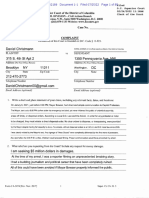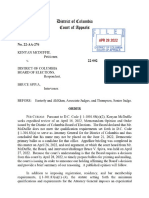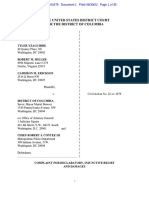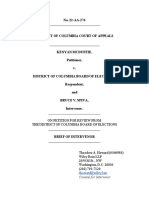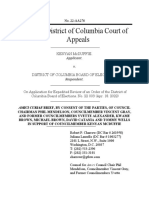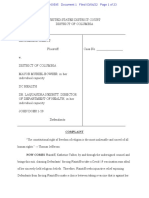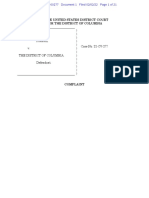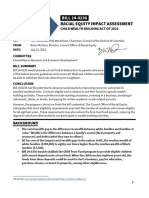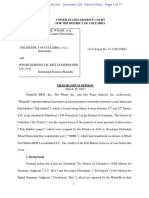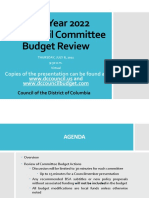Professional Documents
Culture Documents
Capital Bikeshare 2011 Survey Executive Summary
Uploaded by
Martin AustermuhleOriginal Description:
Copyright
Available Formats
Share this document
Did you find this document useful?
Is this content inappropriate?
Report this DocumentCopyright:
Available Formats
Capital Bikeshare 2011 Survey Executive Summary
Uploaded by
Martin AustermuhleCopyright:
Available Formats
Capital Bikeshare 2011 Member Survey
Executive Summary
Prepared by: LDA Consulting Washington, DC 20015 (202) 548-0205
June 14, 2012
Capital Bikeshare 2011 Member Survey Report
June 14, 2012
EXECUTIVE SUMMARY
Overview
This report presents the results of the 2012 Capital Bikeshare Customer Use and Satisfaction Survey conducted for the Capital Bikeshare program (Capital Bikeshare). Capital Bikeshare, a program jointly owned and sponsored by the District of Columbia and Arlington County, VA and operated by Alta Bicycle Share, Inc., offers short-term use of more than 1,500 bicycles to registered members and day-pass users at more than 165 stations in the District of Columbia and Arlington County. Users register for an annual or 30-day membership and receive a Capital Bikeshare key that allows them to unlock a bike at any station. Users can return the bike to the same station or to any other station in the network, facilitating both return and one way trips. Capital Bikeshares management were interested in users experience with the program and exploring bikeshares impact on users travel patterns. The survey was conducted for four primary purposes:
Examine demographic characteristics of Capital Bikeshare users Examine use characteristics of Capital Bikeshare trips Examine travel changes made in response to Capital Bikeshare availability Examine users satisfaction with Capital Bikeshare features
The survey was administered online to registered Capital Bikeshare members. Capital Bikeshare staff sent an email to its approximately 18,000 members that informed them of the online survey and provided the link to the survey website. During the approximately one-month period that the survey website was active, 5,464 members completed the survey, for a total response rate of 31%.
Key Conclusions
Several overall conclusions related to the travel impacts and personal travel benefits of bikesharing rise to the top of importance. Capital Bikeshare members benefit through easier, faster access to destinations and access to a wider range of destinations Almost half of respondents had made a trip in the past month that they would not have made without bikeshare. Of these respondents, 64% said they would not have made the trip because it was too far to walk, so bikeshare broadened their travel destination options. Other respondents reported reasons related to characteristics of the destination or time of travel: no transit/inconvenient transit to the destination or at that time of day, limited/expensive parking at the destination, too much traffic at destination, or dont like to drive at that time of day. For these members, bikeshare expanded their easy and convenient travel options. More than half (56%) of recent bikeshare trips were for non-work purposes About 22% of respondents used bikeshare most recently for a social/entertainment trip and 13% made an errand/personal appointment trip. About four in ten recent trips were to go to work (19%) or go from work (19%).
Capital Bikeshare 2011 Member Survey Report
June 14, 2012
A large share of Capital Bikeshare members increased their use of bicycling Eighty percent of survey respondents said they bicycled more often now than they did before joining Capital Bikeshare and 70% of respondents who increased bicycle use said Capital Bikeshare had been important in helping or encouraging them to ride more often. Capital Bikeshare availability influenced net reductions in auto use by program members Four in ten survey respondents drove a car less often and 94% of respondents who reduced driving indicated that Capital Bikeshare had been at least somewhat of a factor contributing to the reduction in driving. Thirty-eight percent of respondents who had access to a personal vehicle reduced their annual driving miles by an average of 523 miles annually. Based on this individual reduction, the 18,000 bikeshare members (in November 2011) reduce nearly 5 million driving miles per year. Bikeshare members appear to have shifted some trips to bicycle from taxi, transit, and walking More than half (56%) of respondents reduced their use of taxi, 47% ride Metrorail less often, and 39% reduced their use of bus since joining Capital Bikeshare. Bikeshare members who used Capital Bikeshare frequently reported the greatest reduction in use of non-bicycle modes A net 44% of respondents who said they bike more often reduced use of a car compared to a net 26% of those who had no change in bike use, a gap of 18 percentage points. The gap in percentage reduction was similar for use of taxi (16 percentage points) and Metrorail (17% points), and only slightly smaller for bus (13 points). On average, each Capital Bikeshare member saves $819 per year on personal travel cost Respondents reported saving an average of $15.75 per week on personal transportation costs as a result of their bikeshare use, about $819 over the course of the year. Across the estimated 18,000 Capital Bikeshare members in November 2011, the collective saving is almost $15 million each year. Respondents gave high marks to most bikeshare features More than three-quarters gave ratings of 4 or 5 (Excellent) to the Capital Bikeshare website, safety of stations, map at stations, and mechanical repair of bikes. Seventy-three percent rated the call center as a 4 or 5. Respondents were less satisfied with the nighttime lighting at stations; 58% gave a rating of 4 or 5 to this feature.
Bikeshare Users Demographic and Membership Characteristics
Bikeshare users do not mirror the adult population of the Washington metropolitan region More than nine in ten survey respondents were employed, while the U.S. Census reportes only about seven in ten adults in the Washington region are employed. But bikeshare survey respondents also differ from the general employed population. Compared to all commuters in the region, they are, on average, considerably younger, more likely to be male and Caucasian, highly educated, and slightly less affluent. Bikeshare visibility and referrals are important marketing tools for Capital Bikeshare Respondents were most likely to have heard about Capital Bikeshare by seeing a Capital Bikeshare station (39%), seeing someone riding a Capital Bikeshare bike (22%), or through a referral from a friend or family member (26%). The other important source was the Living Social deal." It was named by 15% of respondents overall, but 25% of those who joined between April and June 2011.
ii
Capital Bikeshare 2011 Member Survey Report
June 14, 2012
The primary motivations for joining Capital Bikeshare were access and speed More than eight in ten (85%) respondents said they were motivated by the ability to get around more easily or more quickly. Two-thirds said they liked to bike or thought biking was a fun way to travel and 46% cited a desire to save money on transportation.
Bikeshare Use Characteristics
Capital Bikeshare use was distributed evenly across frequency categories, showing demand for the service at many use levels About two in ten (18%) respondents had made one or two bikeshare trips in the past month, 21% made between three and five trips, and 17% made between six and ten trips. About 24% were frequent users, making 11 or more trips in the past month. On average, respondents made about 8.1 trips per user in the past month. Survey respondents used bikeshare most often for personal / non-work trips Overall, the top two bikeshare trip purposes were social/entertainment and errands/personal appointments; about twothirds of respondents had made a trip at some time for each of these purposes. More than half (56%) had used bikeshare for a trip to a restaurant or other location where they had a meal, 40% made a bikeshare trip to shop, and 36% used Capital Bikeshare for an exercise or recreation trip. Six in ten respondents used bikeshare to make a commute trip, that is, either to go TO work (55%) or to go FROM work (59%) and 31% used bikeshare to go to a meeting. Capital Bikeshare also served as a feeder service to reach transit stops More than half of all respondents used Capital Bikeshare to get to or from a Metrorail station and about two in ten used it to access a bus stop. Bikeshare was more often used to get FROM transit than TO transit. This could reflect greater interest in using bikeshare for evening or late night trips home, when respondents are especially safety conscious. More than half (56%) of respondents recent bikeshare trips were made for non-work purposes About 22% said their most recent bikeshare trip was for a social/entertainment purpose, 13% made an errand/personal appointment trip, seven percent made their most recent trip to go to a restaurant, and seven percent made a trip for exercise. About four in ten recent bikeshare trips were to go to work (19%), go from work (19%), or go to a meeting (6%). Work trips were among the most common recent trips, but they were less common overall than some other purposes. This suggests they are frequent trips, but concentrated among a smaller share of respondents. Forty-five percent of respondents would have ridden a bus or train if Capital Bikeshare had not been available for the most recent trip Three in ten (31%) would have walked to their destination. Only seven percent of respondents would have driven or ridden in a personal vehicle, but since almost half of respondents did not have a personal vehicle regularly available, this would not have been an easy option for many. Six percent would have used a taxi and six percent would have ridden a personal bike. Respondents options for making these trips differed by the type of trip they were making Six in ten respondents whose last trip was to go to or from work would have used transit for the trip. Respondents whose last trip was for errands or shopping were more likely to say they would have used a personal
iii
Capital Bikeshare 2011 Member Survey Report
June 14, 2012
vehicle or walked than were respondents generally. Respondents also were more likely than average to use a personal vehicle for a trip to a restaurant. Respondents whose last Capital Bikeshare trip was to go to a meeting were substantially more likely than other respondents to say they would use a taxi.
Use of Capital Bikeshare to Induce Trips
In the past month, 44% of respondents used bikeshare to make at least one trip they would not have made (induced trips) if bikeshare had not been available Four in ten respondents made an induced social/entertainment trip, about three in ten made trips to restaurants and errand/personal appointment trips, and a quarter made an induced shopping trip. But only one percent of respondents mentioned making an induced trip to go to work and two percent made a trip to go from work, but this seems reasonable, as work-related trips would not generally be considered discretionary trips. The vast majority of induced trips were made to destinations in the District of Columbia Downtown DC was the most common destination overall; three in ten (30%) respondents made an induced trip to this area. About a quarter (25%) made a trip to Capitol Hill and two in ten made trips to Shaw / U Street (20%) or Georgetown (19%). Nearly two-thirds (64%) of respondents said they would not have made the trips without Capital Bikeshare because it was too far to walk This suggests respondents might have substituted some induced trips to distant destination for trips they might have made to locations closer to their origin location. In this way, Capital Bikeshare broadened the travel destination options. Other common reasons were related to characteristics of the destination or time of travel: no transit/inconvenient transit to the destination or at that time of day, limited/expensive parking at the destination, too much traffic at destination, or dont like to drive at that time of day. Two in ten (19%) wanted to get exercise and 17% didnt have a car. Capital Bikeshare access makes establishments more attractive to Bikeshare members More than eight in ten respondents said they were either much more likely (31%) or somewhat more likely (52%) to patronize an establishment that was accessible by Capital Bikeshare. The remaining 17% said bikeshare access was not a factor in their choice of establishments. Respondents who gave high ratings for the value of bikeshare access made induced trips at a much higher rate than did those who gave lower ratings Sixty-two percent of respondents who said they were much more likely to patronize a Capital Bikeshare-accessible establishment had made in induced trip, compared with 43% who said they were somewhat more likely, and only 20% of those who said they were not more likely to patronize the establishment. This suggests that the decision to make some, and perhaps many, of the induced trips was motivated by the establishments accessibility.
iv
Capital Bikeshare 2011 Member Survey Report
June 14, 2012
Change in Mode Use Since Joining Capital Bikeshare
More than eight in ten respondents increased bike use since joining Capital Bikeshare More than a third (36%) said they bicycled much more often and 46% said they bicycled more often. Seventy percent of respondents who increased bicycle use said Capital Bikeshare had been important in helping or encouraging them to ride more often. Respondents who reported a greater increase in overall bike use also reported more frequent Capital Bikeshare use. Respondents who said they bike much more often made an average of 12.0 trips in the past month, compared with 6.2 trips for respondents who bike more often, and 4.4 trips for those who did not change bike use. Bikeshare members substantially reduced their use of Metrorail, bus, and taxi since they joined Capital Bikeshare Nearly half (47%) ride Metrorail less often and 39% ride a bus less often. Only seven percent of respondents increased use of Metrorail and six percent increased bus use. Respondents also decreased their use of walking, overall, but the reduction was not as substantial as for transit. Thirty-one percent said they walk less often, but 17% of respondents now walk more often. Fifty-three percent reduced their use of taxi. Bikeshare members substantially reduced their use of car Four in ten (41%) survey respondents drove a car less often; no respondents increased use of car. More than nine in ten respondents who reduced driving indicated that Capital Bikeshare had been a factor contributing to the reduction. Bikeshare members who used Capital Bikeshare frequently reported the greatest reduction in use of nonbicycle modes For example, a net 44% of respondents who said they bike more often reduced use of a car compared to a net 26% of those who had no change in bike use, a gap of 18 percentage points. The gap in percentage reduction was similar for use of taxi (16 percentage points) and Metrorail (17% points), and only slightly smaller for bus (13 points). Nearly four in ten respondents reduced their annual driving miles Respondent who had access to a personal vehicle also were asked approximately how many miles they drove per month in the year before they joined Capital Bikeshare and since joining Capital Bikeshare. Thirty-eight percent reduced their driving miles; 14% reduced driving by more than 1,000 miles. About half (56%) of respondents who reported their mileage made no change in driving miles; only six percent increased their driving miles. Capital Bikeshare members reduce nearly five million driving miles annually On average, survey respondents who reported both a current and pre-Capital Bikeshare mileage drove about 4,015 miles per year before joining Capital Bikeshare and 3,492 per year since joining, for a reduction of about 523 miles annually. When these survey results are applied to the estimated 18,000 bikeshare member population in November 2011, the month in which the survey was conducted, the results are as follows:
Number of bikeshare members (November 2011) Bikeshare members with vehicle available (53%) Estimated annual VMT reduced per member Estimated total annual VMT reduced
18,000 9,540 523 4,989,400 annual miles
Capital Bikeshare 2011 Member Survey Report
June 14, 2012
On average, each Capital Bikeshare member saves $819 per year on personal travel cost Nearly all (90%) respondents thought Capital Bikeshare had saved them money. Two-thirds saved between one dollar and $20 per week, 25% saved more than $20. On average, respondents saved $15.75 per week, or about $819 over the course of the year. Across the estimated 18,000 Capital Bikeshare members in November 2011, the aggregate savings are nearly $15 million per year:
Number of bikeshare members (November 2011) Estimated annual cost saving per member Estimated total annual cost saving
18,000 $819 $14,742,000 annually
Bikeshare Members Commute Travel Patterns
Capital Bikeshare members travel an average of 6.2 miles to work one-way, less than half of the average 16.3 miles distance of commuters region-wide Two in ten bikeshare respondents travel fewer than two miles to work and 63% travel fewer than five miles. By contrast, only 17% of all regional commuters travel fewer than five miles. Capital Bikeshare members drive alone to work much less than do comm uters region-wide The overwhelming majority of employed respondents use a nondrive-alone mode of travel to get to work: 47% by public transit, 23% by biking, and 13% by walking. Only 12% of commute trips were made by driving alone, well below the 65% drive alone mode share for all commuters in the Washington region. About a quarter of employed respondents started or increased use of a non-drive alone mode since joining bikeshare Fifteen percent started or increased use of bicycle, six percent made a change to public transit, and three percent made a continued change to walk. And additional 32% of respondents tried a new drive-alone mode or use a new mode occasionally. Access to bicycle support services appeared to influence use of bicycle for work travel Bikeshare survey respondents were twice as likely to report that they employers offered bike racks, showers, personal lockers, and other bicycle-support services (53%) as were all commuters region-wide (26%) and were more likely to have bicycle services than were other commuters in the jurisdictions where they worked. Respondents who had access to bicycle-support services biked to work at a higher rate than did respondent who did not have access to these services; 33% of respondents who said bicycle services were available bicycled to work, compared with 21% of those who did not have bicycle services.
Satisfaction with Capital Bikeshare
Respondents gave generally high marks to bikeshare features More than three-quarters gave ratings of 4 or 5 (Excellent) to Capital Bikeshare website, safety of stations, map at Capital Bikeshare stations, and mechanical repair of bikes. Seventy-three percent rated call center as a 4 or 5. Respondents were less satisfied with the nighttime lighting at the stations; 58% of respondents rated this feature as 4 or 5. Capital Bikeshare offers numerous ways that members can obtain information about the service and manage their use of the service Seven-six percent of respondents said they had used the Capital Bikeshare
vi
Capital Bikeshare 2011 Member Survey Report
June 14, 2012
online map in the past month to locate a station to pick up or drop off a bike; 30% used the map one or two times, 22% had used the map between three and five times and 24% had used the map at least six times. A very large share (87%) of respondents said they were aware of the smart phone app called SpotCycle, with which members could locate Capital Bikeshare stations and learn if a bike was available at the station. Seventy-two percent had used the app. About four in ten respondents reported some problem with using Capital Bikeshare services A quarter (25%) said they had issues accessing a bike with the membership key, 24% said they had a mechanical issue with the bike, and 22% said they had an issue with a bike dock. Likelihood to encounter problems was connected to when respondents joined Capital Bikeshare and how often they used the service Respondents who joined in the early period of the program encountered more problems overall than have respondents who joined more recently. The percentage of respondents who reported each of these problems has since declined, but it is not possible to know if the decline reflects that the system has become more trouble-free or if it reflects more recent members shorter time exposure to the system. Respondents also were more likely to say they had encountered one or more of these issues if they were more frequent bikeshare users. More than half (55%) of respondents who made 11 or more Capital Bikeshare trips in the past month had encountered a problem with the service, compared with 37% of respondents who made just one or two Capital Bikeshare trips in the past month.
vii
You might also like
- 1 Civil ComplaintDocument24 pages1 Civil ComplaintMartin Austermuhle100% (1)
- High Capacity Magazines LawsuitDocument24 pagesHigh Capacity Magazines LawsuitMartin AustermuhleNo ratings yet
- Daniel ChristmannDocument85 pagesDaniel ChristmannMartin AustermuhleNo ratings yet
- I 82 LawsuitDocument49 pagesI 82 LawsuitMartin AustermuhleNo ratings yet
- Order Granting Motion For Summary AffirmanceReversalDocument4 pagesOrder Granting Motion For Summary AffirmanceReversalMartin Austermuhle100% (1)
- USAO Sutton ResponseDocument71 pagesUSAO Sutton ResponseMartin AustermuhleNo ratings yet
- Zabavsky DismissalDocument38 pagesZabavsky DismissalMartin AustermuhleNo ratings yet
- I82 ResponseDocument52 pagesI82 ResponseMartin AustermuhleNo ratings yet
- Sutton DismissalDocument41 pagesSutton DismissalMartin AustermuhleNo ratings yet
- Ammo Case Complaint As FiledDocument23 pagesAmmo Case Complaint As FiledMartin AustermuhleNo ratings yet
- Complaint As Filed MetroDocument35 pagesComplaint As Filed MetroMartin AustermuhleNo ratings yet
- Koma ResponseDocument44 pagesKoma ResponseMartin AustermuhleNo ratings yet
- District of Columbia Board of ElectionsDocument12 pagesDistrict of Columbia Board of ElectionsMartin AustermuhleNo ratings yet
- In The District of Columbia Court of Appeals: Applicant, VDocument26 pagesIn The District of Columbia Court of Appeals: Applicant, VMartin AustermuhleNo ratings yet
- MMB Policy Letter To Council 5-3-22Document13 pagesMMB Policy Letter To Council 5-3-22Martin AustermuhleNo ratings yet
- FI14153 DC Mobile Voting ToplineDocument10 pagesFI14153 DC Mobile Voting ToplineMartin AustermuhleNo ratings yet
- BOE McDuffie ResponseDocument26 pagesBOE McDuffie ResponseMartin AustermuhleNo ratings yet
- Spiva ResponseDocument49 pagesSpiva ResponseMartin AustermuhleNo ratings yet
- Victoria White LawsuitDocument22 pagesVictoria White LawsuitMartin AustermuhleNo ratings yet
- In The District of Columbia Court of Appeals: Applicant, VDocument120 pagesIn The District of Columbia Court of Appeals: Applicant, VMartin AustermuhleNo ratings yet
- Order (Devita Swann Street Cases)Document38 pagesOrder (Devita Swann Street Cases)Martin AustermuhleNo ratings yet
- McDuffie - Amici.4.21.2022v3 (002) FinalDocument12 pagesMcDuffie - Amici.4.21.2022v3 (002) FinalMartin AustermuhleNo ratings yet
- Foia LawsuitDocument26 pagesFoia LawsuitMartin AustermuhleNo ratings yet
- Cloakroom LawsuitDocument28 pagesCloakroom LawsuitMartin AustermuhleNo ratings yet
- DC Lawsuit Vax MandateDocument23 pagesDC Lawsuit Vax MandateMartin AustermuhleNo ratings yet
- Heller Lawsuit 2Document41 pagesHeller Lawsuit 2Martin AustermuhleNo ratings yet
- Doc. 1 Complaint & ExhibitDocument36 pagesDoc. 1 Complaint & ExhibitMartin Austermuhle100% (1)
- Racial Equity Impact Assessment: BILL 24-0236Document17 pagesRacial Equity Impact Assessment: BILL 24-0236Martin AustermuhleNo ratings yet
- Fish MarketDocument77 pagesFish MarketMartin AustermuhleNo ratings yet
- Fiscal Year 2022 DC Council Committee Budget Review: WWW - Dccouncil.us andDocument43 pagesFiscal Year 2022 DC Council Committee Budget Review: WWW - Dccouncil.us andMartin AustermuhleNo ratings yet
- The Subtle Art of Not Giving a F*ck: A Counterintuitive Approach to Living a Good LifeFrom EverandThe Subtle Art of Not Giving a F*ck: A Counterintuitive Approach to Living a Good LifeRating: 4 out of 5 stars4/5 (5783)
- The Yellow House: A Memoir (2019 National Book Award Winner)From EverandThe Yellow House: A Memoir (2019 National Book Award Winner)Rating: 4 out of 5 stars4/5 (98)
- Never Split the Difference: Negotiating As If Your Life Depended On ItFrom EverandNever Split the Difference: Negotiating As If Your Life Depended On ItRating: 4.5 out of 5 stars4.5/5 (838)
- Shoe Dog: A Memoir by the Creator of NikeFrom EverandShoe Dog: A Memoir by the Creator of NikeRating: 4.5 out of 5 stars4.5/5 (537)
- The Emperor of All Maladies: A Biography of CancerFrom EverandThe Emperor of All Maladies: A Biography of CancerRating: 4.5 out of 5 stars4.5/5 (271)
- Hidden Figures: The American Dream and the Untold Story of the Black Women Mathematicians Who Helped Win the Space RaceFrom EverandHidden Figures: The American Dream and the Untold Story of the Black Women Mathematicians Who Helped Win the Space RaceRating: 4 out of 5 stars4/5 (890)
- The Little Book of Hygge: Danish Secrets to Happy LivingFrom EverandThe Little Book of Hygge: Danish Secrets to Happy LivingRating: 3.5 out of 5 stars3.5/5 (399)
- Team of Rivals: The Political Genius of Abraham LincolnFrom EverandTeam of Rivals: The Political Genius of Abraham LincolnRating: 4.5 out of 5 stars4.5/5 (234)
- Grit: The Power of Passion and PerseveranceFrom EverandGrit: The Power of Passion and PerseveranceRating: 4 out of 5 stars4/5 (587)
- Devil in the Grove: Thurgood Marshall, the Groveland Boys, and the Dawn of a New AmericaFrom EverandDevil in the Grove: Thurgood Marshall, the Groveland Boys, and the Dawn of a New AmericaRating: 4.5 out of 5 stars4.5/5 (265)
- A Heartbreaking Work Of Staggering Genius: A Memoir Based on a True StoryFrom EverandA Heartbreaking Work Of Staggering Genius: A Memoir Based on a True StoryRating: 3.5 out of 5 stars3.5/5 (231)
- On Fire: The (Burning) Case for a Green New DealFrom EverandOn Fire: The (Burning) Case for a Green New DealRating: 4 out of 5 stars4/5 (72)
- Elon Musk: Tesla, SpaceX, and the Quest for a Fantastic FutureFrom EverandElon Musk: Tesla, SpaceX, and the Quest for a Fantastic FutureRating: 4.5 out of 5 stars4.5/5 (474)
- The Hard Thing About Hard Things: Building a Business When There Are No Easy AnswersFrom EverandThe Hard Thing About Hard Things: Building a Business When There Are No Easy AnswersRating: 4.5 out of 5 stars4.5/5 (344)
- The Unwinding: An Inner History of the New AmericaFrom EverandThe Unwinding: An Inner History of the New AmericaRating: 4 out of 5 stars4/5 (45)
- The World Is Flat 3.0: A Brief History of the Twenty-first CenturyFrom EverandThe World Is Flat 3.0: A Brief History of the Twenty-first CenturyRating: 3.5 out of 5 stars3.5/5 (2219)
- The Gifts of Imperfection: Let Go of Who You Think You're Supposed to Be and Embrace Who You AreFrom EverandThe Gifts of Imperfection: Let Go of Who You Think You're Supposed to Be and Embrace Who You AreRating: 4 out of 5 stars4/5 (1090)
- The Sympathizer: A Novel (Pulitzer Prize for Fiction)From EverandThe Sympathizer: A Novel (Pulitzer Prize for Fiction)Rating: 4.5 out of 5 stars4.5/5 (119)
- Her Body and Other Parties: StoriesFrom EverandHer Body and Other Parties: StoriesRating: 4 out of 5 stars4/5 (821)
- Stahl Cable Festoon SystemsDocument24 pagesStahl Cable Festoon SystemsDaniel SherwinNo ratings yet
- List of Yale University GraduatesDocument158 pagesList of Yale University GraduatesWilliam Litynski100% (1)
- BEE 027 Microcontroller Based System DesignDocument83 pagesBEE 027 Microcontroller Based System DesignBen StarkNo ratings yet
- Data Sheet 3VA2225-5HL32-0AA0: ModelDocument7 pagesData Sheet 3VA2225-5HL32-0AA0: ModelJENNYNo ratings yet
- Vissim 11 - ManualDocument1,219 pagesVissim 11 - Manualmauricionsantos60% (5)
- FSK Demodulator With PLLDocument5 pagesFSK Demodulator With PLLHema100% (1)
- Understanding ProbabilityDocument14 pagesUnderstanding ProbabilityKajaraiNo ratings yet
- TeramisoDocument1 pageTeramisoNasriyah SolaimanNo ratings yet
- Urban Altoids EDC Kit v2.2.1Document2 pagesUrban Altoids EDC Kit v2.2.1richard philpNo ratings yet
- Portarlington Parish NewsletterDocument2 pagesPortarlington Parish NewsletterJohn HayesNo ratings yet
- Factors Supporting ICT Use in ClassroomsDocument24 pagesFactors Supporting ICT Use in ClassroomsSeshaadhrisTailoringNo ratings yet
- Igpu GHZ Cache RM Igpu GHZ CachermDocument2 pagesIgpu GHZ Cache RM Igpu GHZ CachermbuzzbsodNo ratings yet
- Practice Ch3Document108 pagesPractice Ch3Agang Nicole BakwenaNo ratings yet
- The Bedford Clanger May 2013 (The Beer Issue)Document12 pagesThe Bedford Clanger May 2013 (The Beer Issue)Erica RoffeNo ratings yet
- 3G Ardzyka Raka R 1910631030065 Assignment 8Document3 pages3G Ardzyka Raka R 1910631030065 Assignment 8Raka RamadhanNo ratings yet
- FM Approval Standard - 2000 - Automatic Sprinkler PDFDocument130 pagesFM Approval Standard - 2000 - Automatic Sprinkler PDF이상우No ratings yet
- (OBIEE11g) Integrating Oracle Business Intelligence Applications With Oracle E-Business Suite - Oracle Bi SolutionsDocument11 pages(OBIEE11g) Integrating Oracle Business Intelligence Applications With Oracle E-Business Suite - Oracle Bi SolutionsVenkatesh Ramiya Krishna MoorthyNo ratings yet
- Cereal Partners World Wide (Case Presentation)Document42 pagesCereal Partners World Wide (Case Presentation)Misbah JamilNo ratings yet
- Logiq 180 UsuarioDocument414 pagesLogiq 180 UsuariolaboratorioelectroNo ratings yet
- Flexi CE in RAS06-NokiaDocument39 pagesFlexi CE in RAS06-NokiaNikan AminiNo ratings yet
- Business Process Reengineering and Performance Improvement in The BankDocument12 pagesBusiness Process Reengineering and Performance Improvement in The BankYakut Rumani SultanNo ratings yet
- KRAFT SOFTWARE SOLUTIONS Awards CriteriaDocument2 pagesKRAFT SOFTWARE SOLUTIONS Awards CriteriaAbdul SyedNo ratings yet
- 3 Axis AccelerometerDocument9 pages3 Axis AccelerometerResearchDesignLabNo ratings yet
- Marine Products Systems CatalogueDocument97 pagesMarine Products Systems CatalogueJhonnatan Quispe Franco100% (1)
- The Eco-Core SnowboardDocument51 pagesThe Eco-Core SnowboardmoisesmoronsolerNo ratings yet
- Marc Sans, Barcelona ActivaDocument17 pagesMarc Sans, Barcelona ActivaPromoting EnterpriseNo ratings yet
- Bosley Declaration - FTC VemmaDocument69 pagesBosley Declaration - FTC VemmaThompson BurtonNo ratings yet
- MT6771 Android ScatterDocument27 pagesMT6771 Android ScatterСенильга МакароваNo ratings yet
- Introducing Global PoliticsDocument8 pagesIntroducing Global PoliticsMeann Joy BaclayonNo ratings yet
- Announcement: Inter-And Intra-Sectoral Dynamics For Transforming Indian AgricultureDocument8 pagesAnnouncement: Inter-And Intra-Sectoral Dynamics For Transforming Indian AgricultureEnamul HaqueNo ratings yet


